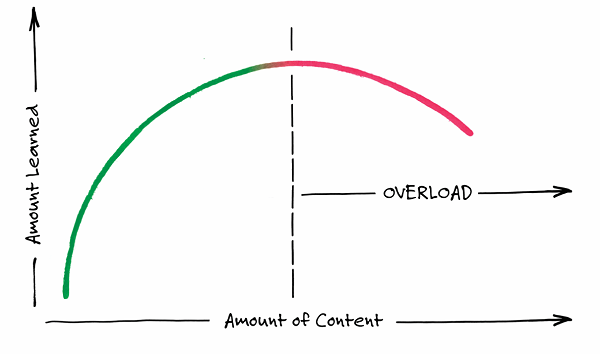ATD Blog
Want to Improve Your Batting Average? Cut Back on Content
Wed Dec 02 2015

Bookmark

This is the third installment in our series on improving your training “batting average.” In baseball, a player’s batting average is the number of base hits per times at bat. The higher your batting average, the more valuable you are. In learning and development, your batting average is how often you improve performance per training initiative. The higher your batting average, the more valuable you are. In this installment, we’ll look at the relationship between content and effectiveness.
Too Much of a Good Thing
Everyone has heard the expression, “Content is king.” That may be true, but there comes a point when content turns into a despotic ruler that actually harms its subjects.
How Can That Be? Isn’t More Content Better?
Initially, yes. But courses with too little content result in superficial learning. Increasing the amount of content increases the amount learned, but not indefinitely. Beyond a certain point—when more and more content is stuffed into a course, or the course time is reduced without any concomitant reduction in content—more content actually decreases the amount learned.
Why Does That Happen?
Deep learning—that is, learning that includes real insight and understanding and the ability to apply—requires linking new knowledge to existing neural networks in meaningful ways. That process requires time and reflection. When too much content is presented too quickly, learners experience cognitive overload. They don’t have the capacity to process the new information in working memory. As a result, they fail to grasp essential principles and confuse core concepts with trivial details.
Courses are often overstuffed with content because we rely on subject matter experts. Their very expertise may cloud their judgment about what is essential. The late human-performance expert Joe Harless admitted in a 1989 Training article, “Wasted Behavior: A Confession,” that “early in my career, I set about determining what to teach based on the question, ‘What do you want people to know?’ The problem with asking subject matter experts (SMEs) that question is that they’d tell me everything they knew.” And what subject matter experts know is way more than novices can absorb. “Once I realized my folly, I . . . began to insist that SMEs answer the question, ‘What do you want them to do on the job?’”
We also tend to overstuff courses with content because we confuse instruction with learning. As Ruth Clark has wisely pointed out, “Content covered is not content learned.” In other words, just because you went over it in class does not mean that people learned it. Real learning takes active engagement; you cannot just pour knowledge into people’s heads. Skills require practice.
Too much content squeezes out time for practice and meaningful feedback, which research has shown is vital to effective learning. Too often, facilitators cut short discussions and talk faster as the end of the course approaches, explaining that “we just have to get through this.” That doesn’t sound like learning; that sounds like an ordeal.
Bottom Line
Less is more. Too many corporate training programs are overstuffed with content—so much so that learners experience cognitive overload. When that happens, both the quality and depth of their learning suffers. If we want to improve our batting average for delivering training that works, we need to keep the amount of content within manageable limits.
Want to Learn More?
To understand more about how to transfer training, join us for an upcoming Learning Transfer Certificate Program
Editor’s Note: Adapted from Pollock, R., A. Jefferson, and C. Wick. 2015. The Six Disciplines of Breakthrough Learning. 3rd Edition. Alexandria, VA: ATD Press; Hoboken, NJ: Wiley.
Figure Source: The 6Ds Company. Copyright 2015. Used with permission.
More from ATD

